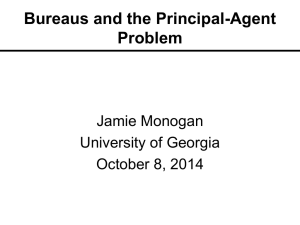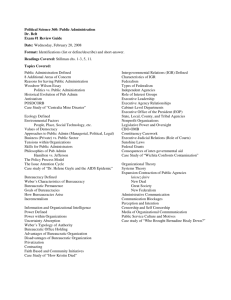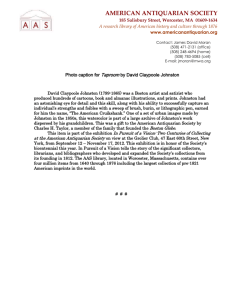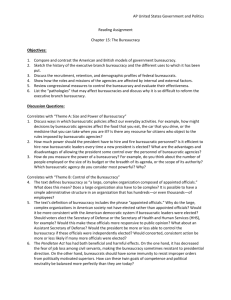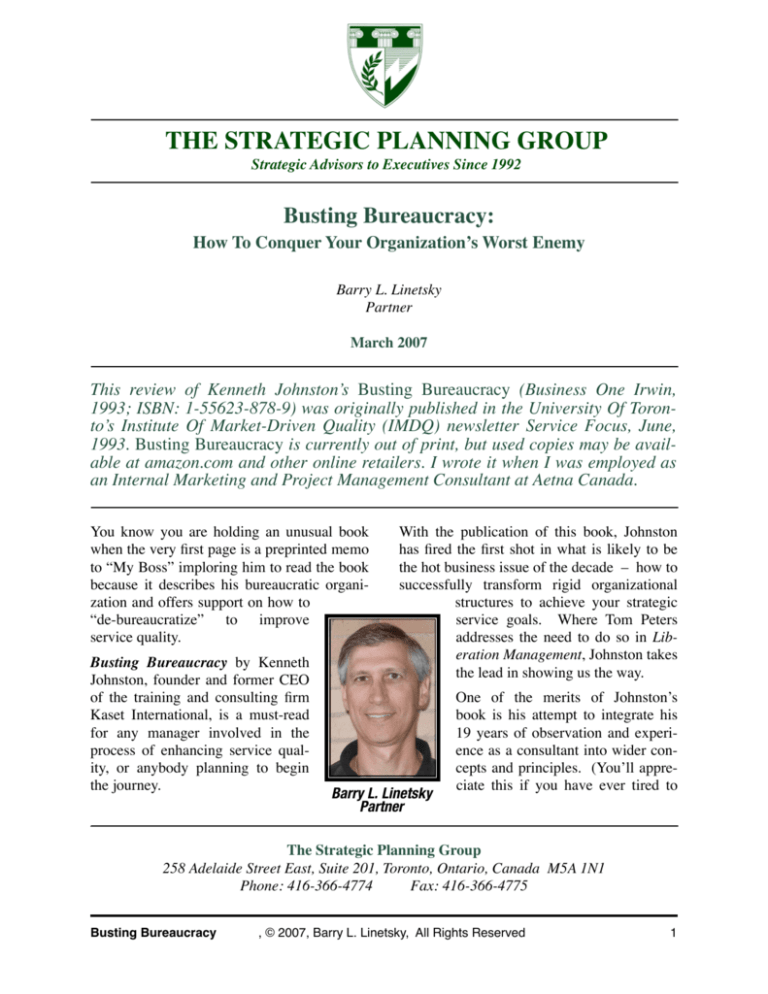
THE STRATEGIC PLANNING GROUP
Strategic Advisors to Executives Since 1992
Busting Bureaucracy:
How To Conquer Your Organization’s Worst Enemy
Barry L. Linetsky
Partner
BarryBarry Linetsky Barry Linetsky
March 2007
This review of Kenneth Johnston’s Busting Bureaucracy (Business One Irwin,
1993; ISBN: 1-55623-878-9) was originally published in the University Of Toronto’s Institute Of Market-Driven Quality (IMDQ) newsletter Service Focus, June,
1993. Busting Bureaucracy is currently out of print, but used copies may be available at amazon.com and other online retailers. I wrote it when I was employed as
an Internal Marketing and Project Management Consultant at Aetna Canada.
You know you are holding an unusual book
when the very first page is a preprinted memo
to “My Boss” imploring him to read the book
because it describes his bureaucratic organization and offers support on how to
“de-bureaucratize” to improve
service quality.
Busting Bureaucracy by Kenneth
Johnston, founder and former CEO
of the training and consulting firm
Kaset International, is a must-read
for any manager involved in the
process of enhancing service quality, or anybody planning to begin
the journey.
With the publication of this book, Johnston
has fired the first shot in what is likely to be
the hot business issue of the decade – how to
successfully transform rigid organizational
structures to achieve your strategic
service goals. Where Tom Peters
addresses the need to do so in Liberation Management, Johnston takes
the lead in showing us the way.
Barry L. Linetsky
Partner
One of the merits of Johnston’s
book is his attempt to integrate his
19 years of observation and experience as a consultant into wider concepts and principles. (You’ll appreciate this if you have ever tired to
The Strategic Planning Group
258 Adelaide Street East, Suite 201, Toronto, Ontario, Canada M5A 1N1
Phone: 416-366-4774
Fax: 416-366-4775
Busting Bureaucracy
, © 2007, Barry L. Linetsky, All Rights Reserved
1
read Liberation Management.) By doing so,
What is required, says Johnston, is much
he provides a path for the reader to follow in
more than a change in corporate culture. The
understanding why bureaucracy exists and
bureaucratic form must be replaced by flexiwhy certain organizations
ble, responsive, innovative
react to it in certain ways.
“mission driven” organizaBureaucracy perseveres
Most importantly, he shows
tions that have customer
so
well,
asserts
how the quality service confriendly policies, practices
Johnston, because it
cepts and tools can be utilized
and procedures. Johnston’s
tends to produce the
to remove bureaucratic hinvision of a non-bureaucratic
highest levels of
drances to service excellence.
mission-driven form and the
personal satisfaction for steps required to achieve it are
Expert opinion is that 80-90%
those at the top.
outlined in the book. Without
of quality initiatives are likely
this conversion, says Johnto fail. Johnston provides
ston,
most organizations that
some insight into why this may
are currently engaged in quality programs
be so with a significant though seemingly
will be defeated by the underlying bureaubanal observation. His experience shows that
cratic structure.
when organizations begin to undertake service quality improvement programs, the negative effects of bureaucracy are noticeably
reduced. But in later stages, bureaucracy
tends to become the primary barrier to further
improvement. Departments don’t cooperate,
internal politics get in the way of fulfilling the
mission and decision-making seems to take
forever.
Once the bureaucratic veneer
is removed, what remains
exposed is the core structure
that supports bureaucracy. In
essence, the enemy is ourself.
Given the statist nature of bureaucratic structures, it is not surprising that Johnston concludes that the competitive pressure of a free
market is the best single impetus to force organizations to become market driven. “Bureaucracies can only succeed,” he writes,
“when protected by tariffs, patents, copyrights, market positioning,
oligopoly, or outright monopJohnston concludes that
oly. In truly competitive arethe competitive pressure nas, unmodified bureaucratic
of a free market is the
organizations seldom can earn
best single impetus to
the customer satisfaction
force organizations to
needed to compete.”
become market driven:
Bureaucracy perseveres so
Busting Bureaucracy is well
well, asserts Johnston, not
“In truly competitive
researched, lucid, and spatonly because it is the most
arenas, unmodified
tered with humour. It is also a
common organizing model
bureaucratic
thoughtful read in the way it
for private and public sector
organizations seldom
challenges the reader through
organizations, but also becan earn the customer
categorical statements backed
cause it tends to produce the
satisfaction needed to
by inductive reasoning. Johnhighest levels of personal
compete.”
ston combines concrete exsatisfaction for those at the
amples
with conceptual analytop. These are the very same
sis to provide prescriptive frameworks within
people, we are told, who must be the most
which solutions can be found. What separates
staunch supporters of an organizational
this book from most management books is its
change effort if it is to have any hope of sucrefreshing bold assertiveness.
ceeding.
Busting Bureaucracy
, © 2007, Barry L. Linetsky, All Rights Reserved
2
In Busting Bureaucracy, Johnston is throwing
down the gauntlet. In confronting the bureaucratic kings, his passion is his challenge: “I
believe there is no legitimate reason for any
public or private sector organization that aspires to quality products or customersatisfying service to continue using the bureaucratic form.”
In the opening page memo to “My Boss,” one
of the options you may select is “I was so
excited about this book that I ordered a bunch
to pass around. Please read it and let’s talk.”
Not only is this a good marketing technique,
it is excellent advice. Take Johnston’s lead.
Be bold and fire the first shot in your own
organization. Do your customers, employees
and owners a favour: make a gift of Busting
Bureaucracy to your senior executives, and
start building a customer driven organization
today. Your company’s survival in the 1990s
may depend on it.
About
The Strategic Planning Group
The Strategic Planning Group (T.S.P.G.) is a full service consulting firm that can provide organizations with a wide range of advice, business tools and solutions. At T.S.P.G. our focus is on helping
our clients solve their complex issues to realize their ultimate business potential, whether we are
helping to set the overall strategy for the organization or assisting in a particular functional area. Our
practical-results-oriented approach to solving business problems, combined with our personal commitment and dedication to providing great value for our clients, makes us the consultants of choice to
blue-chip executives across North America.
We aspire to be more than just consultants. For us to be successful in helping you we need to understand how you operate and what challenges you are currently facing. We want to help you achieve
your goals and your ultimate business potential. To accomplish this we must be trusted and objective
advisors by contributing our knowledge, experience and thinking in ways that have a positive impact.
We want to be your consultants of choice – as we are for other senior executives – for all of your
strategic business needs.
How to Reach Us
The Strategic Planning Group
258 Adelaide Street East, Suite 201
Toronto, Ontario M5A 1N1
Tel: (416) 366-4774 Fax: (416) 366-4775
www.tspg-consulting.com
Busting Bureaucracy
, © 2007, Barry L. Linetsky, All Rights Reserved
3


